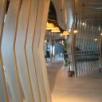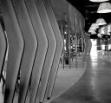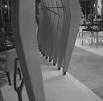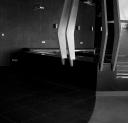


ribs
April 24, 2007


zlgdesign developed a screen inspired by boat building technology, the timber ribs translated into vertical ribs to achieve a screen partition like space divider. Read the rest of this entry »
black and white for duyong
April 24, 2007


Minimize colors to allow shapes, patterns and textures to express themselves.
Duyong
April 24, 2007


Shades of movements in between boatlike curved screens at Duyong The Heritage Bay Club house. Opened for the Monsoon Cup 2007 in Kuala Terrenganu at east coast of Malaysia.
Redez office
March 13, 2007 
Article in Trends Magazine about Derek Wong Redez office renovation works completed 2005
press release: New Straits Times
March 7, 2007Susanne Zeidler is a tad miffed when I ask her what her philosophy of design is. I should be able to tell, she says, by looking at her work. She believes her work should speak for itself.
We have been looking through some of the design she has created in the past, both of building and furniture; yet, being a complete ignoramus in the field of design. I need to have her spell out exactly what her philosophy is. Is it all about simplicity? I prod. After all, that word has crept up so often in her vocabulary in the past hour, that I am inclined to think she design on simple lines. The Frankfurt-born architect relents: “What is simplicity? It can be anything. I think it is more apt to say my philosophy is to stir the emotions. I want my work to evoke emotions in people’s mind when they see it.” Aha! So it’s that ‘wow!’ factor. Well, she has certainly evoked my emotions with her designs, especially her bed creation, a masterpiece inspired by the French artist Yves Klein, who was always drawn to the limitless blue expanses of sea and sky. Susanne’s bed is done along the lines of ‘waves’, using car material comprising sheet moulding composite (SMC) and aluminium. Blue is the predominant colour used throughout, both to signify ‘waive’ and in tribute to Klein’s strong influence with the colour blue. (Klein created and patented the ultramarine colour known as International Klein Blue or IKB.)
The center of Susanne’s bed is made of timber strips clipped to the sides of the bed frame to hold it together. Then a mattress goes over it, and hey presto! It becomes a futon bed. Susanne built a prototype of it and had it exhibited at a furniture fair organized by Faber-Castell in Germany in 1989, the year when she was still pursuing her studies. After the fair, she just stored the bed and did not take things any further. She studied art history for a year before embarking on architecture studies at Polytechnic School, Fachhochshule in Frankfurt/Main. This was followed by postgraduate studies at Staedle Schule in Germany under Prof. Peter Cook of Archigram fame (Archigram was the British architectural group that become arguably the pre-eminent architectural neo-avant garde of the 1960s and early 1970s). Susanne then won a one-year scholarship to study at the Bartlett School of Architecture in London. She has worked at different design offices in Germany and lives in London for three years prior to moving to Malaysia, where she has set up base for the past 13 years. Currently she manage design firm ZLG Sdn Bhd together with her partner Huat Lim. Susanne has come a long way since her student days, and has achieved much success both in terms of furniture designs and architectural feats. In Malaysia, she has vast experience in hospitality and residential designs. In the award-winning I-Zen show unit at Mont Kiara, Kuala Lumpur, Susanne has designed, among other notable features, a floor that folds up into a bench, much like a snake unfurling its body.
The recently opened Cameron Highlands Visitor Centre is another feather in the cap for Susanne. Tropical in concept and approach, and Miesian in organization philosophy, the center is an example of fine composition in lines and materiality. (German architect Ludwig Mies van der Rohe’s less-is-more modernism led the radical transformation of architecture during the 1920s and 1930s). Calling herself a designer above all else, Susanne asserts there are no boundaries between architecture and furniture design.
“I design building, spaces, products, furniture; everything is related to everything.” She says.
Her first furniture design in Malaysia was in 1994 for a café in the Sogo shopping complex. It was a giraffe chair. What do you expected of a chair? Steel legs and a wooden seat? Susanne designed her giraffe chair the other way round: steel seat and wooden legs. The idea was for the seat to be slotted into the legs. Her choice of material depends not just on the aesthetics but on economics as well, she says. “A lot of my work is intuitive and how I perceive my surroundings. I also look at the behavior of the materials I select.” For her designs, she starts by doing sketches, then creates three – dimensional visuals using the computer. This is followed by a series of technical drawings, after which the designs are passed to the furniture manufacturer or the person who buys the designs. Susanne’s second design project in 1955 took off in the form of a total concept décor for the Chilly restaurant in Cheras Leisure Mall, Kuala Lumpur. She designed everything for the restaurant, from its interior to its furniture.
“I put timber in the furniture and also timber strips on the floor which followed a ‘wave’ design.” She recalls.
For her next project, the Puncakdana show units, Susanne opted for the cold look of steel, whereby all the furniture she designed came with steel legs: sofa, coffee table, dining table, TV cabinet etcetera. Another show unit in the same project has a tropical look to it, complete with rattan and wooden furniture. “It was a holistic approach, where the complete look mattered more than the individual parts,” she says. The Cyberia Zone 2 show unit in Cyberjaya, which Susanne designed, has a lovely bed design with wall cladding. Her children (budding artist) did some sketches, which Susanne then printed on film to put behind glass, and had box lights installed. This wall cladding as the bed headboard is a very eyecatching kaleidoscope of colours. In Susanne’s opinion, there are more furniture design innovations in Western countries, because they have the money and the resources. But Malaysia is not lacking in resources such as rattan and wood, which can be used to create amazing products, she says.
“We’re not looking an inventing innovation; we’re looking at using what we have in our midst innovatively. Take plywood. This is a simple material but we can do amazing things with it. To me, the shape and the form of products is important; so is the symbolism, whether you want your product to be invisible or to be stand out. But most times, designing furniture is about economics and marketing strategies,: says Susanne. She doesn’t believe in trends, which tend to be short-lived. She believes in designing products that will have long-lasting appeal rather than become a trend only to fizzle out. And she encourages thinking out of the box.
“Take seating for example. The whole idea of seating need not be so structured. Other than proper chairs, raised platforms can be used as seating; even humorous chairs, such as foam chairs glued together!” In this context, ZLG has designed seats made from acrylic, resembling bubbles, for the DIGI HQ lounge area. Bar chair which the company has also designed used timber veneers, and bent metal steelwork for the seat.
This metal seat is treated to show the reflective qualities and strong character of steel, and the metallic silver polish of the powder-coating process. Fixings in the bar chairs are invisible, through using concealed metal lugs and brackets hidden under the timber legs, or behind them. Another furniture design that Susanne is proud of is a conference table, where fixings for table leg and support details are also made in an invisible fashion, with a punched hole for fitting and pin connections, to allow maximum demountability.
Susanne feels furniture design should not remain exclusive to a select few. She is most happy if many people like her design.
“Exclusive design can be mass produced. Why not? The more people like my designs, the more happier I will be,” she concludes.
Article in newspaper New Straits Times February 2006
helena
March 7, 2007Thursday 30.03.2006
The day was incredible.
It is school now! Of course, still waiting for my brother. i had no one to play with till I found a ball used by the boys. I even had to play football alone and the football was like a basketball. I saw a squirrel passing by with thick fur. well, of course, no one could catch a squirrel. i followed it, it was afraid, was cute too. Than stooped playing, instead i walked around the school. Before that i saw two girls dressing as normal school mates. But they weren’t, I saw them dancing on the window. they even came out whipping their lips, so strange! There are cats in the school. Just saw one walking by and another, and another, and I tried to pet one but it ran away. I saw a butterfly pass by, once I looked back it was gone. Never mind, butterflies are not so important, right?! I wanted to go to the toilet but I was too scared, sang songs while I was bored. Then rain started to come , wind started blowing and birds chirped loudly.
I met a teacher named Ms. Huey. I didn’t know her so much. She just looked at me and waved bye. I waved back [she can not speak]. she is of course from Fairview. Heard a thunder after that. I was scared.
Leaves were scattered and moving from the wind. Then it started raining. Finally, i saw the butterfly again. But it flew away because it was scared. Then, over here, it started raining heavily. than my brother come back. Finally, and the boys, which are my brothers friends were shouting like crazy. Bye, and that’s the end of my real story.
from Helena 9 years old.
people
March 7, 2007PEOPLE
We come in different shapes and sizes,
and we come in different characters.
We have different talents,
and we have different families.
Some people are kind,
some people are rude.
Some people don’t even have food.
Some people look quite the same,
Just like twins or brothers and sisters.
Some people have hard life’s
and they get more harm,
like more and more blisters.
Some people look good
some people look bad,
and some people are thin,
some people are fat.
It doesn’t matter what at least they behave kind to me.
from [my daughter] helena 9 years young Feb. 2006
When I am happy……
March 7, 2007When I am happy……..
When i am happy I smile.
When I smile people look at me and smile back.
When I am happy I hang out with my friends.
When I hang out with my friends I always find it fun.
When i am happy i sing.
When i sing I sing happy songs.
When i am happy I talk to my parents.
when I talk to my parents they always answer me back.
from Helena 8 years old



